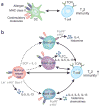The many paths to asthma: phenotype shaped by innate and adaptive immunity
- PMID: 20562844
- PMCID: PMC3114595
- DOI: 10.1038/ni.1892
The many paths to asthma: phenotype shaped by innate and adaptive immunity
Abstract
Asthma is a very complex and heterogeneous disease that is characterized by airway inflammation and airway hyper-reactivity (AHR). The pathogenesis of asthma is associated with environmental factors, many cell types, and several molecular and cellular pathways. These include allergic, non-allergic and intrinsic pathways, which involve many cell types and cytokines. Animal models of asthma have helped to clarify some of the underlying mechanisms of asthma, demonstrating the importance of T helper type 2 (T(H)2)-driven allergic responses, as well as of the non-allergic and intrinsic pathways, and contributing to understanding of the heterogeneity of asthma. Further study of these many pathways to asthma will greatly increase understanding of the distinct asthma phenotypes, and such studies may lead to new therapies for this important public health problem.
Conflict of interest statement
The authors declare no competing financial interests.
Figures



References
-
- Wilson DH, et al. Trends in asthma prevalence and population changes in South Australia, 1990–2003. Med J Aust. 2006;184:226–229. - PubMed
-
- Umetsu DT, Mcintire JJ, Akbari O, Macaubas C, DeKruyff RH. Asthma: an epidemic of dysregulated immunity. Nat Immunol. 2002;3:715–720. - PubMed
-
- von Mutius E. Gene-environment interactions in asthma. J Allergy Clin Immunol. 2009;123:3–11. - PubMed
Publication types
MeSH terms
Substances
Grants and funding
LinkOut - more resources
Full Text Sources
Other Literature Sources
Medical

